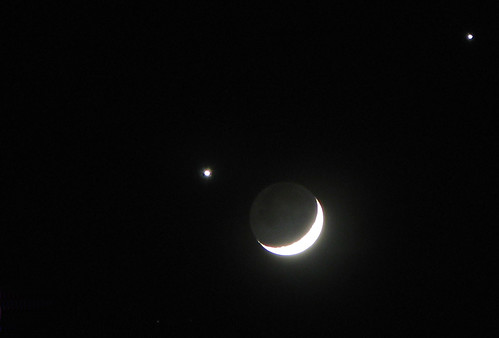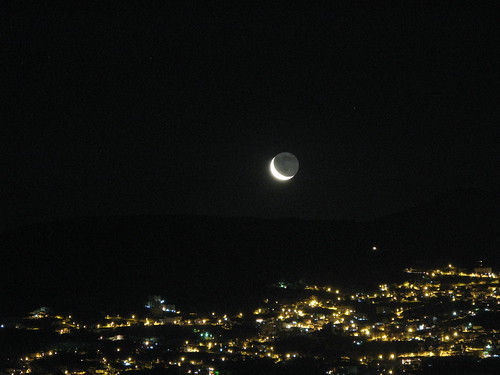This post is one of a series of short posts on the three main astroimaging techniques; scenic, afocal, and prime focus. This series is also part of a larger series on the fundamentals of astroimaging which are based on a presentation was preparing a while ago. For today I will introduce you to the first, the scenic image which you naturally take quite often. As a start here's the definition of "scenic":
Scenic: Of or pertaining to scenery; of the nature of scenery; theatrical [1913 Webster]
As the definition implies, such an image is one of people or anything in the foreground along with some natural scene in the background. By natural scene I mean a scene of nature; a scene with trees or mountains or land or the horizon or anything Earthly or a combination of those.
This imaging technique is a relatively easy to use as people do it all the time, naturally; all that it requires is some perception. I chose this this particular technique for this post since a very nice imaging opportunity [1] is coming soon which you could use to both learn this imaging technique and to take a nice astroimage with relative ease. All you need is your cam and your tripod (or use your imagination & skills to position the cam on a surface with the right angle & direction; for example you could use a table mount, or an inclined book).
What you need to do is simple;
- place your cam such that the lower side of your screen is horizontal (i.e; collinear with the horizon); it wouldn't be nice if the image turned out to be inclined, would it?
- Turn on the cam, turn the flash off
- Zoom in/out so that the planets, moon, & star are all in the fram along with Earthly objects (e.g; trees, mountain, maybe partial clouds)
- take a "test" image of the conjunction
- Adjust the settings accordingly & take another test image
- How does the image look? Are the planets, stars, moon well focused? Anything you don't like? If so, repeat the previous step, until satisfied.
That's it. It is that simple. Once the settings are adjusted correctly all it takes is to push the button, and voila. You've got a good image. Now what differentiates a good image from a great one is the finely "adjusted settings" (with a personal flavor), the location & hence the scene of the image.
I'll leave you with some images and some tips.
Notice the Crescent? the clouds? the mountains and lights? the fog? This is an example of a scenic image.
 |
| Smiley (almost) face formed by the Crescent, Venus & Jupiter on Dec.1, 2008. |
 |
| Scenic of the Crescent rising over the mountains & street lights on June.20, 2009. |
 |
| Scenic of the Crescent, Venus (lower right), & Jupiter over the mountain on June.20, 2009. |
Tips
- Charge your cam's battery or make sure you have replacements.
- Turn off the cam's flash or auto-flash: this is always applicable to astroimaging!
- Focus is everything: make sure you focus on the object well; if you have manual focus use that instead of auto focus (infinity is the "usual" best option).
- Take some test images to see the result with the current cam settings and adjust the settings (one at a time if you're just beginning) accordingly and testing again.
- exposure? make use of twilight
- You may want to be comfortable with your cam on the respective date of the conjunction, so it is good to try this early on. Every morning, Jupiter, Venus, & Aldebaran rise slightly before twilight (~ 0350 hrs)
Do not forget to share your images with us either by emailing us at astrobob.tk (at) gmail (dot) com or by joining our flickr group (see About page) & adding your images to our pool (restricted to Lebanese imagers!)
Thanks for reading :)
and clear skies!


Great tips! Concerning focusing, on my camera, the infinity focus is slightly out of focus for the sky. I focus on a bright star or the moon (most stars are too dim to be seen in the camera's viewfinder), or take a series of test shots, changing the focus slightly each time until it's just right. What Astrobob said is true, focus is critical. So make sure your images are focused well and repeat your shots if necessary before calling it a day.
ReplyDelete